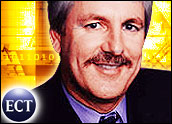
Last week I wrote about three companies that had either followed an Apple-like strategy (Gateway), utilized ex-Apple employees (OQO), or executed on a founding Apple principle (AMD/Microsoft).
This week we’ll examine three more companies that owe a lot of what they are to Apple, as part of my not-so-subtle look at what might have been had Apple been able to keep these ideas, concepts and people inside the company.
I’ve often thought of this as the Xerox curse. Apple took the concepts that defined its platform from Xerox, which at the time was led by executives who simply could not see the potential of what they had. But perhaps Apple caught this curse along with the technology. They are now trending towards 1 percent of the market they founded because they too were unable to embrace the brilliance of some of their employees or stay focused on the very concepts that founded the company.
PalmSource and PalmOne
Perhaps the greatest corporate offspring from Apple are the Palm companies. At one time the combined entity enjoyed a market cap greater than that of many large multi-national corporations because the platform was so exciting to users. They have dropped from these highs, but by doing what Apple refused to do — separating the software and hardware units — they slowed the market slide towards Microsoft’s offerings and still dominate the handheld computer segment they first made popular.
They do this by emulating the Apple concepts of strong designs and easy-to-use products. PalmOne’s new Tungsten T5 is a case in point, featuring simple, elegant industrial design, adequate performance, a strong hardware user interface (which transitions between Apple and Windows), and an incredibly loyal user base. The T5 even has an incredibly cool keyboard accessory that allows you to add a notebook-sized keyboard so that you can type to your hearts content. PalmOne also has the leading full-featured smartphone, the Treo 650 http://www.palmone.com/us/products/handhelds/tungsten-t5/ , which is the product most commonly carried by early adopters in the market today. The hardware innovation screams Apple. Of course, PalmSource is the other side of this, offering an OS that is as easy to use as the MacOS and a strong competitor to Microsoft’s own offering.
Palm did learn the Apple lesson, however, which makes it different, and more competitive, it two key areas. It separated the hardware and software units to better focus on the distinct markets and to give the firm the chance to grow to its potential. While this growth has been elusive, it did stop the decline, and as a result the two Palms have a much larger share of their segment then Apple has in PCs. The other area is cooperating with Microsoft. Recently they licensed Microsoft’s ActiveSync, allowing Palm products to work seamlessly with Microsoft Outlook and Exchange.
PalmSource and PalmOne are holding their own in a hard-fought market and doing so with a set of products and a strategy Apple chose not to execute. They remain a defining player in handheld computers; Apple largely gave up that role in the PC world years ago. Unfortunately the handheld market is declining, which suggests a little Apple style marketing could help them out a lot here.
Orb Networks
Led largely be people who have worked at Palm and/or Apple, Orb Networks is close to releasing a revolutionary product that executes on one of Apple’s stated strategies: turning the PC into a true digital hub. To date Apple remains more of a peer-to-peer platform in which media moves from Apple PC to Apple PC and sometimes onto an iPod (most of which sell to Windows users anyway). Apple doesn’t seem to want to acknowledge that TV exists and doesn’t yet support video on the iPod at all, even though video editing applications are one of the core advantages of Apple’s PC platform.
Orb Networks turns any device that can run a rich browser into a remote viewing station for video anywhere a network exists. This means you can watch your time-shifted TV shows on your laptop, handheld computer or cell phone (assuming it will run a rich browser), and the same goes for your home videos, pictures, music or virtually any file you want to run or use remotely.
Orb is working with Tivo as well, and there is the hope that this technology may, at some point, move beyond the PC. I got to see this in New York in person, and it is an incredibly compelling experience because the frame rates are very good and the technology can sense the device you have and optimize the experience, on the fly, across both wireless and wired networks.
This could make platforms like Tivo and the Media Center PC vastly more popular and allow others to enter this segment, increasing user choice and fueling the emerging market for media hubs and the devices that use them. Handheld computers, which have a unique transflective screen ideal for watching videos indoors and out, would likely be the biggest beneficiary of this technology. If it succeeds, it could revitalize the handheld segment.
But Apple probably will watch this from the sidelines because they don’t believe people like to watch TV and movies (homemade or otherwise) on portable devices. I can almost hear the old Xerox executives chuckling in the distance.
White Box Robotics
The original Apple was the PC you assembled yourself. Thanks to a part from VIA technologies — a little PC board that is revitalizing innovation in a number of emerging and existing markets — a company is building a kit robot that reminds me of the very first Apple. The strange thing is that it even kind of looks like the original Mac. You could picture this in one of those evolution-style pictures showcasing how the PC learned to walk (or roll in this case).
While the product is, initially, more of a PC that will follow you around the house and do things like play music and scare the cats, it will also allow kids and some adults to become more involved in the emerging robotic segment for a fraction of the cost of similar products. It is a first step, but the original Apple was comparatively limited as well and it spawned an industry. I particularly like the HMV model. I’ll go into more detail on this when I get my own next year,
Is Apple — by being as closed as it is and not encouraging or retaining key people and ideas — suffering from the Xerox PARC curse, or is it simply being prudent and staying focused on what is core to the company? The iPod does seem to be rather far removed from that PC core, and, suddenly, that experiment has taken over the company, suggesting another path.
Of course I’ve left out the most successful Apple child, Microsoft Windows, but that is a story for another day, and probably another writer. Until that day, join with me in wishing these Apple children success in the new worlds they are defining. They are defining our future, and one of these firms may yet become the next Apple.
Rob Enderle, a TechNewsWorld columnist, is the Principal Analyst for the Enderle Group, a consultancy that focuses on personal technology products and trends.





















































